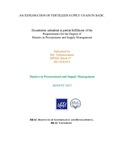| dc.contributor.advisor | Rasheduzzaman, Md. | |
| dc.contributor.author | Tuhinuzzaman, Md. | |
| dc.date.accessioned | 2018-02-06T09:30:08Z | |
| dc.date.available | 2018-02-06T09:30:08Z | |
| dc.date.copyright | 2015 | |
| dc.date.issued | 2015-08 | |
| dc.identifier.other | ID 14282015 | |
| dc.identifier.uri | http://hdl.handle.net/10361/9402 | |
| dc.description | This dissertation is submitted in partial fulfilment of the requirements for the degree of Masters in Procurement and Supply Management, 2015. | en_US |
| dc.description | Cataloged from PDF version of dissertation. | |
| dc.description | Includes bibliographical references (Pages 54-55). | |
| dc.description.abstract | 1. Chemical fertilizer was introduced in Bangladesh in the late 1950s and the fertilizer policy
consisted of one basic tenet-complete public sector control over its procurement and
distribution. This policy continued throughout the 1960s but since the War of Liberation the
policy regime has undergone fundamental changes.
2. Bangladesh Agricultural Development Corporation (BADC) was established in 1961.
Since inception BADC supplies fertilizer to farmer. The responsibility of procuring fertilizer
from both domestic and external sources and distributing to the level of a small
administrative unit (thana) rested solely with BADC.
3. There was a significant shift in policy on fertilizer distribution at the wholesale and retail
levels during late 1970s. Finally, privatization of fertilizer trade was implemented supported
by a policy of price deregulation in the early eighties which empowered the traders to sell at
any price they could fetch in the market.
4. The government excluded fertilizers from the list of import restricted and allowed private
sector to import fertilizer. The subsidy on fertilizers was withdrawn completely in December
1992 and importation and distribution of fertilizer made open.
5. Fertilizer distribution network is composed of appointed/licensed dealers who are expected
to observe limitation, including selling only within designated areas. Government provides a
supervisory role on the trade which also sets an indicative price level for traders to abide-by.
Farmers collect fertilizers from three different sources: BCIC appointed fertilizer dealers and
their representative (sub-dealer) shops, BADC dealers shops and local fertilizer retailer’s
shops.
6. The economic reasoning for providing fertilizer subsidy lies that it encourages farmers to
produce more (food grain). Government of Bangladesh may opt for a selective, targeted
subsidy scheme in place of the universal coverage of subsidy that is being practiced now.
7. Total fertilizer demand or requirement from household level is considerably higher than
the corresponding official estimates. There is a tendency for fertilizer to be smuggled in or
out depending on the comparative prices of fertilizers on both sides of the border. | en_US |
| dc.description.statementofresponsibility | Md. Tuhinuzzaman | |
| dc.format.extent | 56 pages | |
| dc.language.iso | en | en_US |
| dc.publisher | BRAC University | en_US |
| dc.rights | BRAC University dissertations are protected by copyright. They may be viewed from this source for any purpose, but reproduction or distribution in any format is prohibited without written permission. | |
| dc.subject | BADC | en_US |
| dc.subject | BCIC | en_US |
| dc.subject | BFA | en_US |
| dc.subject | DAE | en_US |
| dc.subject | Fertilizer | en_US |
| dc.title | An exploration of fertilizer supply chain in BADC | en_US |
| dc.type | Dissertation | en_US |
| dc.contributor.department | BRAC Institute of Governance and Development, BRAC University | |
| dc.description.degree | M. Procurement and Supply Management | |

